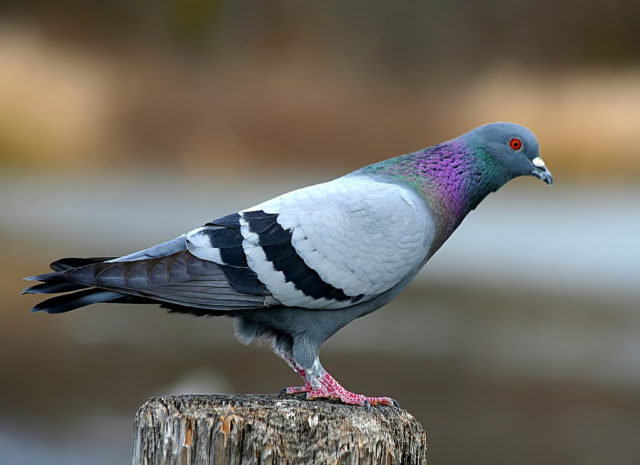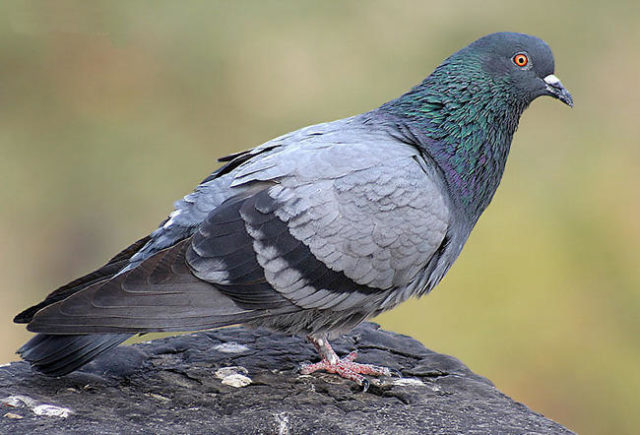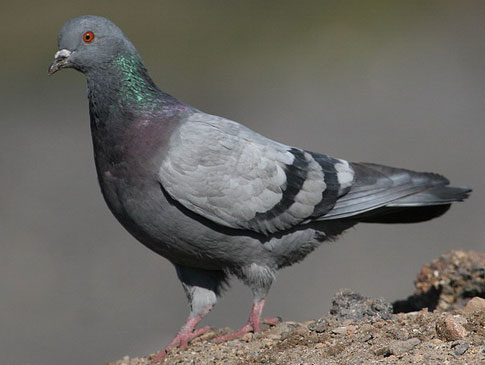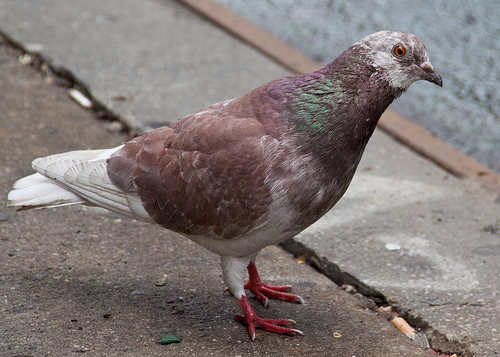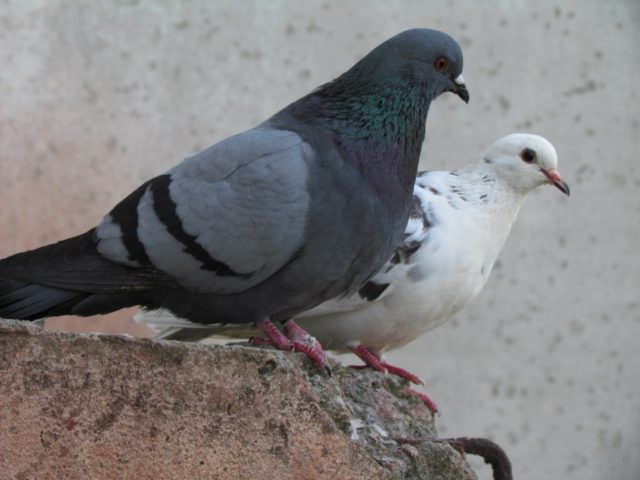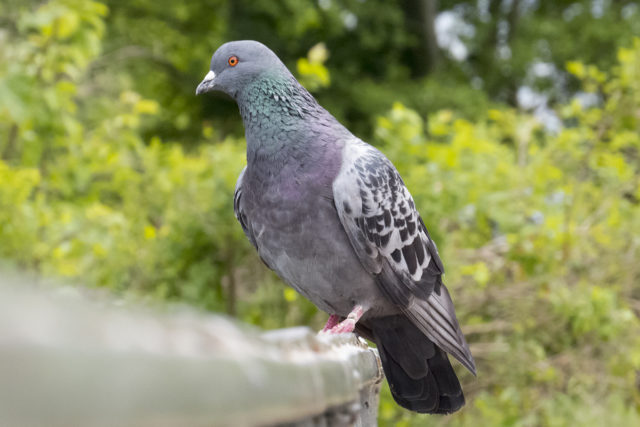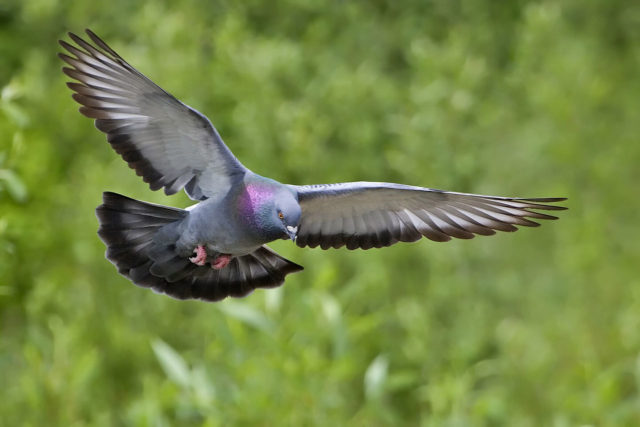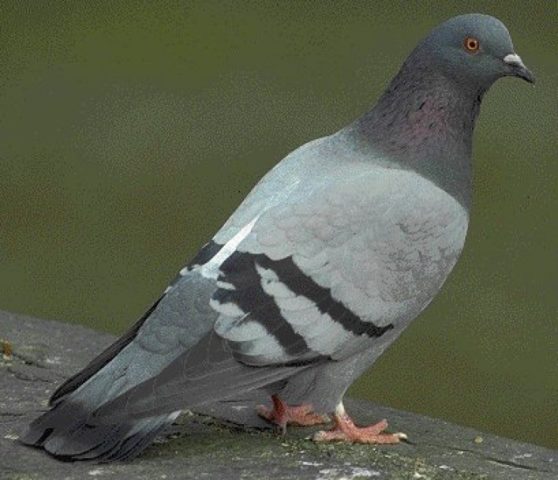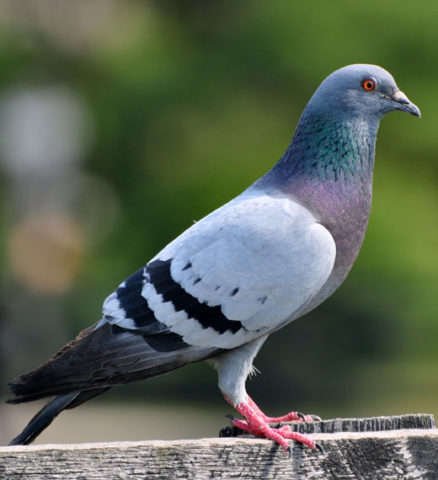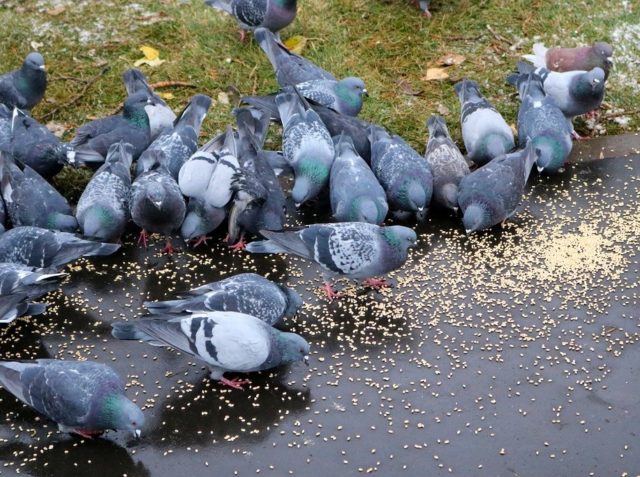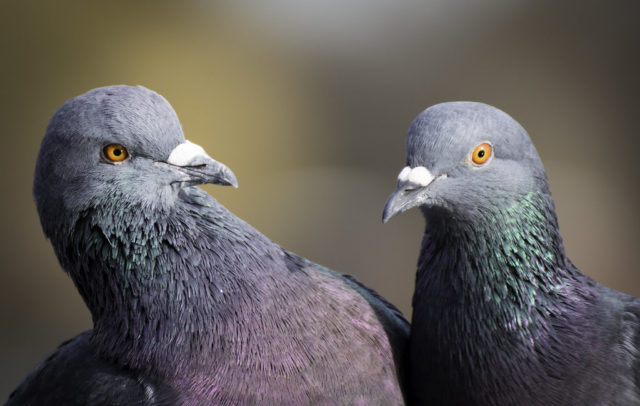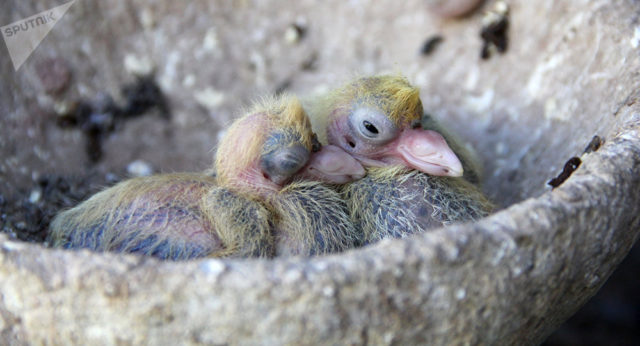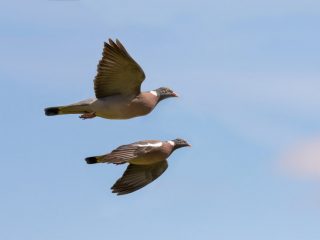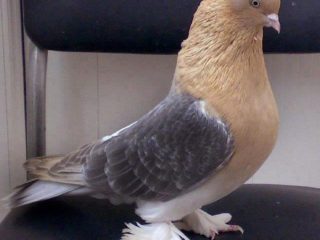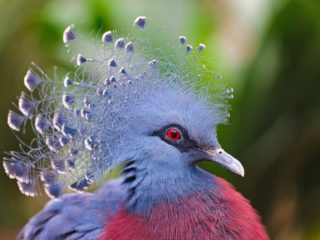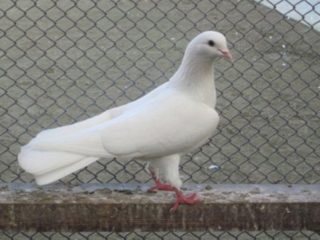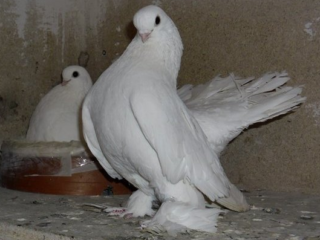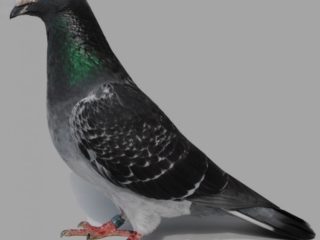Content
The rock pigeon is the most common breed of pigeon. The urban form of this bird is known to almost every person. It is impossible to imagine the streets of cities and towns without the flight and cooing of a rock pigeon. It can be found on city streets, in parks, squares, squares, where there is sure to be someone who wants to feed rock pigeons. This is exactly what they expect from a person who treats the bird with understanding and love.
Description of the rock pigeon
A person has long been accustomed to the fact that a rock pigeon always settles next to his home, whose cooing on the roof of the house is associated with peace and tranquility. Since ancient times, many peoples have shown honor and respect to this bird. For some, the dove was a symbol of fertility, for others - love and friendship, for others - divine inspiration.
The Rock Pigeon species belongs to the family of pigeons and includes two main forms, distributed across almost all continents of the globe.
Wild rock pigeons living in nature, far from humans.
Wild sisars are uniform in appearance and have the same bluish-gray color, which is dictated by survival conditions and, for safety reasons, allows them to merge with the entire flock.
Synanthropic pigeons living near people.
At the same time, among urban rock pigeons there are individuals that have significant differences in plumage color.
Appearance
Among other species of pigeons, the rock pigeon is considered a large bird, second in size only to the wood pigeon. Although differing in color, rock pigeons can otherwise be described in the same way:
- body length reaches 30-35 cm, wingspan - from 50 to 60 cm;
- weight can reach up to 380-400 g;
- plumage color - light gray with a metallic, greenish or purple tint on the neck;
- the wings are wide and pointed towards the end, have two clearly defined transverse stripes of a dark color, and the rump is white;
- in the lumbar region there is a remarkable light spot about 5 cm in size, which is noticeable when the bird’s wings are open;
- The pigeon's legs can be pink to dark brown, sometimes with some feathering;
- eyes have orange, yellow or red irises;
- the beak is black with a light wax at its base.
Urban rock pigeons are more varied in color than wild ones. Currently, according to the color scheme, they are distinguished into 28 species or morphs. Among them there are rock pigeons with brown and white feathers. Apparently, this is the result of crossing street rock pigeons with domesticated pedigree pigeons.
Externally, the male rock pigeon can be distinguished from the female by its more saturated color. Also, the rock pigeon is somewhat larger than the pigeon. Young birds aged 6-7 months do not have such bright plumage as adult pigeons.
The eyes of the rock pigeon are able to distinguish all shades of colors that are accessible to the human eye, as well as the ultraviolet range.A pigeon sees “faster” than a human, since its eye is capable of perceiving 75 frames per second, and a human’s only 24. The rock pigeon’s eye cannot be blinded by a sudden flash or the sun thanks to the connective tissue, which has the property of changing its density in a timely manner.
The sizar's hearing is well developed and is capable of detecting sounds with low frequencies that are inaccessible to human perception.
Voice
The rock pigeon can be recognized by its voice - its cooing, with which it accompanies its active life, is characteristic of the entire family and differs depending on the feeling it expresses:
- inviting cooing is the loudest, emitted to attract the attention of the female, reminiscent of the howl “guut... guuut”;
- an invitation to the nest sounds the same as a call, but at the moment the female approaches it is supplemented by wheezing;
- the pigeon song at the beginning of courtship resembles a quiet purr, which intensifies when the male is excited and turns into loud sounds “guuurrkruu ... guurrkruu”;
- to report danger, the rock pigeon makes short and sharp sounds “gruu... gruuu”;
- The dove accompanies feeding the chicks with soft cooing, similar to meowing;
- Dove chicks make hissing and clicking noises.
In fact, there are a lot of sounds made by rock pigeons. The vocal palette changes depending on the period, condition and age of the bird. Only the birds themselves and, to some extent, people studying pigeons can distinguish them.
Movements
The wild rock pigeon lives in mountainous areas, on rocks, in cracks or caves.He is not used to sitting on a tree and does not know how to do it. The urban rock pigeon has learned to perch on a tree branch, as well as on the eaves or roof of a house.
The pigeon spends the whole day in motion. In search of food, it can fly for several kilometers and is known as an excellent pilot. A wild specimen can reach speeds of up to 180 km/h. Domesticated pigeons reach speeds of up to 100 km/h. A rock dove takes off from the ground very noisily, loudly flapping its wings. The flight itself is strong and purposeful.
Interesting observations of the movement of the rock pigeon in the air:
- if you need to slow down, the pigeon opens its tail “butterfly”;
- when threatened with an attack by a bird of prey, it folds its wings and quickly falls down;
- wings connected at the top help to fly in a circle.
The bird's step when it moves along the ground is also peculiar. It seems that the rock pigeon nods its head when walking. First the head moves forward, then it stops and the body catches up with it. At this time, the image is focused in the retina of the stationary eye. This method of movement helps the pigeon to navigate well in space.
Bird distribution
The wild rock pigeon lives in mountainous and lowland areas with abundant grassy vegetation and nearby flowing bodies of water. It does not settle in forest areas, but prefers open areas. Its habitat covered North Africa, Southern and Central Europe, and Asia. Currently, populations of wild rock pigeons have greatly declined and remain only in some places remote from humans.
Synanthropic, that is, accompanying humans, the rock pigeon is distributed on all continents except Antarctica. These birds can be found in every corner of the world. The urban sisar settles where there is an opportunity to safely nest and feed during the most difficult times of the year. In cold seasons, the wild pigeon descends from the mountains to the lowlands, and the urban pigeon moves closer to human habitation and garbage dumps.
Subspecies of rock pigeon
The rock pigeon from the genus of pigeons (Columba) of the pigeon family (Columbidae) has been described by many researchers. In the reference book “Guide to Pigeons of the World,” David Gibbs classifies rock pigeons into 12 subspecies, which were described at different times by ornithologists from different countries. All these subspecies differ in the intensity of coloring, body size and width of the stripe on the lower back.
It is believed that only 2 subspecies of the rock pigeon currently live in Eastern Europe and Central Asia (the territory of the former USSR).
Columba livia – a nominative subspecies inhabiting Eastern and Central Europe, North Africa, and Asia. The overall color is slightly darker. In the lumbar region there is a white spot measuring 40-60 mm.
Columba livia neglecta – Turkestan rock pigeon, common in the mountains of Central Asia. The color of the plumage is slightly lighter than the nominate subspecies; the neck has a brighter metallic tint. The spot in the sacral area is often gray, less often dark, and even less often white and small in size - 20-40 mm.
It has been noticed that synanthropic rock pigeons living near humans at the present time are very different in color from their relatives described by ornithologists a hundred years ago. It is believed that this is the result of interbreeding with domestic specimens.
Lifestyle
Sisaris live in packs, in which there is no hierarchy, and peaceful proximity is common. They do not make the seasonal migrations characteristic of many birds, but can fly from place to place in search of food. In cold weather, wild individuals descend from the mountains to the valleys, where it is easier to find food, and with the onset of warmth they return home. City pigeons prefer to stay in one place, periodically flying over an area of several kilometers.
In the wild, rock pigeons build nests in rock crevices. This makes them difficult for predators to reach. They can also settle in river mouths and flat areas. Urban individuals settle next to humans in places that remind them of natural conditions: in the attics of houses, in the voids of roofs, under the beams of bridges, on bell towers, and water towers.
Rock pigeons are diurnal and move actively during daylight hours. City pigeons are capable of flying up to 50 km from their nest only in search of food. Sisaris spend about 3% of their energy on such flights. By dusk, they always return home and sleep all night, ruffling their beaks and hiding their beaks in their feathers. In this case, the male’s responsibilities include guarding the nest while the female sleeps there.
A wild pigeon is wary of a person and does not give him the opportunity to get close; he flies away in advance.The urban bird is accustomed to humans, expects food from him, so he allows him to come very close and even eats from his hands. It is rare to see a solitary rock pigeon. The rock pigeon always lives in flocks.
A characteristic feature of a flock of pigeons is to attract their fellows to places favorable for living. They do this during nesting and after it. Having chosen a convenient place to build a nest, the pigeon invites not only the pigeon there, but also other pigeons to settle nearby and create a pigeon colony in which it feels safer.
They also send scouts in search of food. When such a place is found, the scouts return for the rest of the pack. If danger appears, then it is enough for one to give a signal, and the whole flock instantly rises up.
Nutrition
Rock pigeons are omnivorous birds. Due to the small number of developed taste buds in the mouth (there are only 37 of them, while humans have about 10,000), they are not very picky in choosing food. Their main diet consists of plant foods - seeds of wild and cultivated plants, berries. Less commonly, pigeons eat small insects and worms. The type of food depends on the habitat and what the environment has to offer.
Synanthropic individuals have adapted to eat human food waste. They visit crowded places - city squares, markets, as well as elevators, garbage dumps, where they can easily find food for themselves. The weight and structure of the body do not allow pigeons to peck grains from spikelets, but only to lift those that have fallen to the ground.Thus, they do not cause damage to agricultural land.
It has been noted that birds strive to eat large pieces first, judging food by size. They are not shy about snatching a piece, pushing away their relatives and swooping down from above. During feeding, they behave decently only towards their mate. Rock pigeons feed mainly in the morning and during the day, eating from 17 to 40 g of grains at a time. If possible, the city pigeon fills its stomach with food to the limit, and then its crop as a reserve, as hamsters do.
Pigeons drink water differently than most birds. Sisaris plunge their beak into the water and draw it into themselves, while other birds scoop up a small amount with their beaks and throw back their heads so that the water rolls down their throats into the stomach.
Reproduction
Pigeons are monogamous birds and form permanent pairs for life. Before he begins to attract the female, the male finds and occupies a nesting site. Depending on the region and its climatic conditions, nesting takes place at different times. It can begin at the end of February, and egg laying occurs throughout the year. But the main time for laying eggs for pigeons is in spring, summer and the warm part of autumn.
Before mating, a ritual of courtship between the dove and the dove takes place. He tries to attract her attention with all his movements: he dances, moving alternately in one direction or the other, inflates his neck, spreads his wings, coos loudly, makes his tail fan. Often during this period, the male makes lekking flights: the pigeon rises up, loudly flapping its wings, and then glides, raising its wings above its back.
If all this is accepted by the dove, then the male and female show attention and affection to each other, clean the feathers of their chosen one, kiss, which allows them to synchronize their reproductive systems. And after mating, the male makes a ritual flight, loudly flapping his wings.
The nests look flimsy, carelessly made. They are built from small branches and dry grass that the dove brings, and the dove arranges the building materials at its discretion. Nesting lasts from 9 to 14 days. The female lays a clutch of two eggs with an interval of 2 days. The eggs are mainly incubated by the dove. The male replaces her from 10 a.m. to 5 p.m., when she needs to feed and fly to a watering hole.
The incubation period ends after 17-19 days. Pecking of the shell lasts from 18 to 24 hours. Rock pigeon chicks appear one after another with an interval of 48 hours. They are blind and covered with sparse yellowish down, in places with completely bare skin.
For the first 7-8 days, parents feed the chicks with bird's milk, which is produced in their crop. This is a very nutritious food, the consistency of sour cream with a yellowish tint and rich in protein. From this diet, rock pigeon chicks double their weight on the second day. Feeding with milk occurs for 6-7 days, 3-4 times a day. Then parents add various seeds to the milk. Starting from the 10th day of birth, the chicks are fed a highly moistened grain mixture with a small amount of crop milk.
The chicks begin to fly 33-35 days after hatching.At this time, the female begins to incubate the next batch of eggs. Sexual maturity of young pigeons occurs at the age of 5-6 months. The average lifespan of a wild rock pigeon is 3-5 years.
Relationships with a person
Since ancient times, the dove has been revered as a sacred bird. Mention of it was found in manuscripts dating back 5,000 years. In the Bible, the dove is present in the story of Noah, when he sent the bird to search for land. In all religions, the dove symbolizes peace.
Rock pigeons are known to be good postmen. For centuries, people have used them to deliver important messages. What helps pigeons do this is their ability to always find their way home, no matter where they are taken. Until now, scientists have not given an exact answer as to how pigeons do this. Some believe that birds navigate in space using magnetic fields and solar rays. Others argue that rock pigeons use landmarks laid by humans - traces of their life activity.
Synanthropic pigeons are accustomed to humans and are not afraid to come close and take food directly from people’s hands. But in reality, hand-feeding pigeons is not that safe. These birds can infect humans with dozens of dangerous diseases. Birds are also carriers of about 50 species of dangerous parasites. Another problem associated with urban pigeons is that they pollute architectural monuments and city buildings with their droppings.
For a long time, rock pigeons have been used as farm animals. They were bred for meat, fluff, eggs, and fertilizers. Just a century ago, pigeon meat was considered more valuable than the meat of any other bird.
According to statistics, the number of urban sisars is increasing, while the number of wild ones is decreasing.You need to approach the issue of cohabitation between a person and a rock pigeon with understanding. This issue should not be left to chance. Helping to feed outdoor rock pigeons and get rid of avian diseases should be done wisely by a person.
Conclusion
The rock pigeon is a small bird, the benefit of which man has found at all times, using its unusual abilities. At first it was a postman delivering important news, then a member of a rescue team searching for missing people. Man has a lot to learn from pigeons - devotion and fidelity, love and friendship - these qualities symbolize the purity of soul and thoughts. To see in a rock pigeon the good that it brings to a person, you need to know as much as possible about it.
